Thursday, April 9, 2009
OCHA report 1-7/4/2009: Israelis opened fire against farmers in Al Meghazi, damaged houses
extract from OCHA report 1-7/4/2009
Israeli bans on access to agricultural land
near the border and fishing zones continue
During the reporting period, Israeli forces
continued to open fire on Palestinian farmers
and fishermen. Several houses sustained
damage when Israeli forces opened fire on
farmers east of Al Maghazi Camp, forcing
them to leave their land. In addition, Israeli
patrol boats opened-fire on six occasions
towards Palestinian fishermen enforcing the
limitation of the fishing zone to three nautical
miles. According to Al Mezan human rights
centre, on 6 April, Israeli patrol boats opened
fire on a fleet of Palestinian fishing boats
carrying 60 fishermen. During the incident,
Israeli patrol boats detained ten fishermen,
including two children, and confiscated their
boats. The fishermen were released the next
day. No injuries were reported.
Israeli bans on access to agricultural land
near the border and fishing zones continue
During the reporting period, Israeli forces
continued to open fire on Palestinian farmers
and fishermen. Several houses sustained
damage when Israeli forces opened fire on
farmers east of Al Maghazi Camp, forcing
them to leave their land. In addition, Israeli
patrol boats opened-fire on six occasions
towards Palestinian fishermen enforcing the
limitation of the fishing zone to three nautical
miles. According to Al Mezan human rights
centre, on 6 April, Israeli patrol boats opened
fire on a fleet of Palestinian fishing boats
carrying 60 fishermen. During the incident,
Israeli patrol boats detained ten fishermen,
including two children, and confiscated their
boats. The fishermen were released the next
day. No injuries were reported.
Wednesday, April 8, 2009
ISM Gaza Strip Report Wednesday 8th April, Al-Faraheen, the Gaza Strip
ISM Gaza Strip Report
Wednesday 8th April, Al-Faraheen, the Gaza Strip:
This morning, the farmers from Al-Faraheen in the Gaza Strip persisted with their efforts to harvest the year’s crop of lentils. Volunteers with the International Solidarity Movement, and a camera crew from Press TV accompanied the farmers as they set out to work in a field about 300m from the border.
Before the farmers reached the field, an Israeli jeep stopped next to the border fence several hundred metres away. A number of shots were fired in the direction of the farmers before the jeep drove away.
After an hour as the farmers were about to finish their work, another jeep stopped at the border. Soldiers got out and took up firing positions. An ISM volunteer then spoke to them with a megaphone - informing the soldiers that they were all civilians, and requesting that the soldiers did not open fire.
The soldiers then fired several shots at the farming group. The proximity of some of these shots to the farmers was marked by an audible hiss and crack as they ripped through the air past their heads. At this point the farmers decided to leave.
Caoimhe Butterly from the ISM and the Free Gaza Movement said “Today’s action was further evidence of the systematic attacks that border farming communities face. Yet despite this, to sustain their families, farmers must put their lives at risk every day in order to cultivate their land. These acts of popular resistance demand our support. There needs to be continual support in the form of sustained campaigning and action on the issue.”
The Israeli military is attempting to enforce a no-go zone on the Palestinian side of the border. As part of this ongoing project, and in addition to shooting at the communities that live and work in the area, the Israeli military has destroyed large swathes of olive groves, orchards, and other arable land, and hundreds of homes.
Some video footage of the incident:
Labels:
ISM,
Israeli attacks during ceasefire,
video
Tuesday, April 7, 2009
Lost in the Buffer Zone
By Eva Bartlett*
(In Gaza - click here for more photos)
KHAN YOUNIS, Gaza, Apr 6 (IPS) - "They're always shooting at us. Every day they shoot at us," says Alaa Samour (19), pulling aside his shirt to show a scar on his shoulder. Samour said he was shot on Dec. 28 last year by Israeli soldiers positioned along the border fence near New Abassan village, east of Khan Younis in the south of the Gaza Strip.
"We were cutting parsley like we do almost every day, and the soldiers began shooting. We started crawling away. When I got out of the line of fire I realised my shoulder was bleeding and that I had been shot."
A month later, out of necessity, Samour was back in the fields. Like many other impoverished labourers from the Khan Younis area, Samour is employed by farmers to harvest parsley, spinach and pea crops in the fertile eastern region. He brings home 20 shekels (five dollars) per day of labour, his contribution to a family where the father cannot earn enough to cover their food needs.
Sayed Abu Nsereh works on the same land. Well accustomed to the firing from the Israeli soldiers at the border, Abu Nsereh explains how farmers on the field crawl to a 'safe' area - a slight depression in the field - when the shooting begins. Lying face down, they are temporarily safe, though they must still wait for the shooting to cease and the soldiers to leave before they can leave.
The field is roughly half-way into a kilometre-wide band of land running along the Gaza side of the Green Line (Gaza's border with Israel), an area unilaterally designated by Israeli authorities as the 'buffer zone', or more recently, the 'no-go zone'. At inception a decade ago, the 'buffer zone' encompassed a 150 metres wide stretch of land flanking the border south to north. In this region Palestinians could not walk, live or work due to what Israel described as 'security reasons'. It became wasted land, though extremely fertile.
At the end of Israel's three weeks of attacks on Gaza December-January which left more than 1,450 dead and over 5,000 injured, many critically so, Israeli authorities declared an expansion of the 'buffer zone' into what they dubbed a no-go zone expropriating yet more land from farmers and civilians in the area.
Prior to the attacks on Gaza, PARC reported that of the 175,000 dunams (42,000 acres) (1 dunam is 1,000 square metres) of cultivable land in the Gaza Strip, 50,000 dunams (12,000 acres) had been damaged by the Israeli army. These are the most fertile and productive agricultural areas, the 'food basket' areas, the group reports. Following the attacks on Gaza, international bodies put the amount of destroyed land much higher: 60,000-75,000 dunams of farmland they say is now damaged or unusable.
In early February, the Guardian reported on the severe hit to Gaza's agricultural sector. The article quoted representatives of the World Food Programme (WFP) and the Food and Agricultural Organisation (FAO) as saying that anywhere from 35 percent to 60 percent of the agriculture industry was destroyed by Israel's attacks on Gaza, much of it not useable again due to the damage.
Even before the attacks, Gaza's farming sector had been seriously devastated by the crippling siege on Gaza. Whereas Gaza had been producing half of its agricultural needs, the combination of siege and warfare on Gaza has led to the "destruction of all means of life," including destroyed farmland along with hundreds of greenhouses, hundreds of wells and water pumps, and farming equipment.
The ability to produce food is vital to combating staggering malnutrition levels in the Gaza Strip, a region rendered impoverished by Israel's blockade and the consequent soaring unemployment levels. According to PARC, due to the Israeli ban on fertilisers, seeds, plastic sheeting for greenhouses, and irrigation piping, among many other things, there has been a steady regression away from qualitative and productive farming practices: now farmers are planting crops requiring less care, such as wheat and barley, in place of the diversity of vegetables formerly grown. Many, such as Jaber Abu Rjila, believe that Israel's real intention is further land annexation and control. Abu Rjila lives on a farm just under 500 metres from the border in Al-Faraheen, slightly south of Abassan. He and neighbours had jointly cultivated the 300 dunams of land between his home and the border fence, growing a variety of crops including wheat, chickpeas and various greenhouse vegetables. But now, he says, he is only working on four dunams of land.
Since November 2008, Abu Rjila, his wife and their six children have not been able to live at home. The house, pock-marked by bullet holes along its border-facing walls, was subject to regular Israeli army shooting and violence prior to the recent 22 days of Israeli attacks.
In May 2008, all but 500 of Abu Rjila's 3,000 chickens were killed by invading Israeli soldiers, said Abu Rjila. Soldiers at the same time also destroyed what Abu Rjila said was a 12,000 dollar grain harvester and an 8,000 dollar tractor. The asbestos roofing covering the chicken barn shattered from the explosions below which tore out barn walls and killed the poultry.
According to Abu Rjila, the Israeli soldiers destroyed two water pumps for his cistern, and used bulldozers and tanks to raze costly irrigation piping, along with approximately 2,000 different fruit and olive trees and grain plantations over 150 dunams. The Palestinian Centre for Human Rights (PCHR) report on the invasion noted that 225 dunams of agricultural land had been razed in the area.
PCHR notes that the destruction of civilian property, including agricultural land, and the targeting of civilians are illegal under international human rights law including the Fourth Geneva Convention.
The siege is undeniably on Palestinians' minds, but for farmers in the "buffer zone" it is the regular and ongoing shooting from Israeli soldiers that concerns them. Their worries are reasonable: at least two farmers have been shot dead and at least five more injured by Israeli soldiers' gunfire, all since Israel declared ceasefire Jan. 18.
Maher Abu-Rajileh (24) from Huza'ah village, east of Khan Younis, was killed by soldiers that day when he returned with his parents and brother to farmland 400m from the Green Line following Israel's announcement of a ceasefire. At 10 am, after he had spent two hours cleaning up the land from the destruction wreaked by Israeli bulldozers and tanks, Israeli soldiers opened fire, shooting Maher in the chest, killing him instantly.
On Jan. 20, Israeli soldiers fired on residents of Al-Qarara, near Khan Younis, shooting Waleed Al-Astal (42) in his right foot. Soldiers opened fire on Khuza'a village, east of Khan Yunis, on Jan. 23, shooting Nabeel Al-Najjar (40) in the left hand. On Jan. 25, Israeli soldiers shot Subhi Qudaih (55) in the back while he was on Khuza'a village farmland. On Jan. 27, just outside of Al-Farahin, also east of Khan Younis, soldiers killed Anwar Al-Buraim (26), shooting him in the neck while he picked vegetables on land approximately 500m from the Green Line.
On Feb.3, Ismail Abu Taima was among a handful of farmers working to harvest parsley on his land near the border.
"The plants have not been watered for six weeks," Abu Taima said, picking up valves and pieces of irrigation piping. The piping, destroyed by an Israeli army invasion prior to the war on Gaza, has become valuable in a region whose borders are sealed and where replacement parts for most things are unattainable or grossly expensive.
Over the course of a year Abu Taima invests about 54,000 dollars in planting, watering and maintenance of crops on his land. From that investment, if all goes well and crops are harvested monthly, he can bring in about 10,000 dollars a month, enough to pay off the investment and support the 15 families dependent on the harvest. "The borders are closed. We have no feed for our animals," said Abu Taima, pointing to a lone donkey grazing in growth close to the border fence.
Before the afternoon's work had finished, we were subjected to around 45 minutes of intense shooting from three or four soldiers visible on a mound less than 200 metres away, bullets flying within metres of the farmers' heads and feet.
On Feb. 17, farmers returned to harvest land approximately 500 metres from the Green Line where Anwar Al-Buraim was shot dead weeks earlier. As the farm workers were leaving the land, Israeli soldiers targeted Mohammad Al- Buraim, a deaf 20-year-old and cousin of Anwar. Mohammad was with a group of approximately ten farmers pushing their stalled pick-up truck loaded with harvested produce when Israeli soldiers began sniping, hitting Mohammed in the right ankle and continuing to shoot as the farmers, surrounded by international human rights observers, moved away from the field and took shelter behind a nearby house.
The incident was sufficient to deter farmers from returning to that area for a month. When Mazen Samour and Sayed Abu Nasereh returned Mar. 19 to the plot they had been working for roughly two years, it was not to harvest but to rip out the plastic irrigation piping they had carefully laid down months before. At roughly 70 dollars per 250m bundle, the 30 bundles of piping covering the fields was too great an investment to simply leave behind.
"We haven't come back here since Mohammed was shot," said Abu Nasereh. Now, too afraid of being hit by Israeli border soldiers' bullets, the men are abandoning the land for safer ground further inland.
Samour was present when his nephew Alaa Samour was shot in December, as well as when Anwar Al-Buraim was fatally targeted. "We can rent land much further away from the border," said Samour.
Across the border, on the Israeli side, tractors and crop-dusters can be seen working the land immediately next to the Green Line. The 'buffer zone' has been imposed solely on the Palestinian side.
These rural eastern border areas of the Gaza Strip are emptying, the land becoming more and more barren because farmers, many of whom have farmed here for generations, are now too frightened to live and work on their own land. The confines of the Gaza Strip, which is just 40 kilometres long and ten kilometres wide, are being shrunk even further by relentless Israeli invasions, by the imposition of an arbitrary and expanding "buffer zone" and by the targeting of civilians and farmers trying to live on and earn a living from their land.
* Eva Bartlett is an activist-journalist who came to Gaza in November on the third Free Gaza boat. Along with other international witnesses, she was present with farmers during many of the shooting incidents reported.
(In Gaza - click here for more photos)
KHAN YOUNIS, Gaza, Apr 6 (IPS) - "They're always shooting at us. Every day they shoot at us," says Alaa Samour (19), pulling aside his shirt to show a scar on his shoulder. Samour said he was shot on Dec. 28 last year by Israeli soldiers positioned along the border fence near New Abassan village, east of Khan Younis in the south of the Gaza Strip.
"We were cutting parsley like we do almost every day, and the soldiers began shooting. We started crawling away. When I got out of the line of fire I realised my shoulder was bleeding and that I had been shot."
A month later, out of necessity, Samour was back in the fields. Like many other impoverished labourers from the Khan Younis area, Samour is employed by farmers to harvest parsley, spinach and pea crops in the fertile eastern region. He brings home 20 shekels (five dollars) per day of labour, his contribution to a family where the father cannot earn enough to cover their food needs.
Sayed Abu Nsereh works on the same land. Well accustomed to the firing from the Israeli soldiers at the border, Abu Nsereh explains how farmers on the field crawl to a 'safe' area - a slight depression in the field - when the shooting begins. Lying face down, they are temporarily safe, though they must still wait for the shooting to cease and the soldiers to leave before they can leave.
The field is roughly half-way into a kilometre-wide band of land running along the Gaza side of the Green Line (Gaza's border with Israel), an area unilaterally designated by Israeli authorities as the 'buffer zone', or more recently, the 'no-go zone'. At inception a decade ago, the 'buffer zone' encompassed a 150 metres wide stretch of land flanking the border south to north. In this region Palestinians could not walk, live or work due to what Israel described as 'security reasons'. It became wasted land, though extremely fertile.
At the end of Israel's three weeks of attacks on Gaza December-January which left more than 1,450 dead and over 5,000 injured, many critically so, Israeli authorities declared an expansion of the 'buffer zone' into what they dubbed a no-go zone expropriating yet more land from farmers and civilians in the area.
Prior to the attacks on Gaza, PARC reported that of the 175,000 dunams (42,000 acres) (1 dunam is 1,000 square metres) of cultivable land in the Gaza Strip, 50,000 dunams (12,000 acres) had been damaged by the Israeli army. These are the most fertile and productive agricultural areas, the 'food basket' areas, the group reports. Following the attacks on Gaza, international bodies put the amount of destroyed land much higher: 60,000-75,000 dunams of farmland they say is now damaged or unusable.
In early February, the Guardian reported on the severe hit to Gaza's agricultural sector. The article quoted representatives of the World Food Programme (WFP) and the Food and Agricultural Organisation (FAO) as saying that anywhere from 35 percent to 60 percent of the agriculture industry was destroyed by Israel's attacks on Gaza, much of it not useable again due to the damage.
Even before the attacks, Gaza's farming sector had been seriously devastated by the crippling siege on Gaza. Whereas Gaza had been producing half of its agricultural needs, the combination of siege and warfare on Gaza has led to the "destruction of all means of life," including destroyed farmland along with hundreds of greenhouses, hundreds of wells and water pumps, and farming equipment.
The ability to produce food is vital to combating staggering malnutrition levels in the Gaza Strip, a region rendered impoverished by Israel's blockade and the consequent soaring unemployment levels. According to PARC, due to the Israeli ban on fertilisers, seeds, plastic sheeting for greenhouses, and irrigation piping, among many other things, there has been a steady regression away from qualitative and productive farming practices: now farmers are planting crops requiring less care, such as wheat and barley, in place of the diversity of vegetables formerly grown. Many, such as Jaber Abu Rjila, believe that Israel's real intention is further land annexation and control. Abu Rjila lives on a farm just under 500 metres from the border in Al-Faraheen, slightly south of Abassan. He and neighbours had jointly cultivated the 300 dunams of land between his home and the border fence, growing a variety of crops including wheat, chickpeas and various greenhouse vegetables. But now, he says, he is only working on four dunams of land.
Since November 2008, Abu Rjila, his wife and their six children have not been able to live at home. The house, pock-marked by bullet holes along its border-facing walls, was subject to regular Israeli army shooting and violence prior to the recent 22 days of Israeli attacks.
In May 2008, all but 500 of Abu Rjila's 3,000 chickens were killed by invading Israeli soldiers, said Abu Rjila. Soldiers at the same time also destroyed what Abu Rjila said was a 12,000 dollar grain harvester and an 8,000 dollar tractor. The asbestos roofing covering the chicken barn shattered from the explosions below which tore out barn walls and killed the poultry.
According to Abu Rjila, the Israeli soldiers destroyed two water pumps for his cistern, and used bulldozers and tanks to raze costly irrigation piping, along with approximately 2,000 different fruit and olive trees and grain plantations over 150 dunams. The Palestinian Centre for Human Rights (PCHR) report on the invasion noted that 225 dunams of agricultural land had been razed in the area.
PCHR notes that the destruction of civilian property, including agricultural land, and the targeting of civilians are illegal under international human rights law including the Fourth Geneva Convention.
The siege is undeniably on Palestinians' minds, but for farmers in the "buffer zone" it is the regular and ongoing shooting from Israeli soldiers that concerns them. Their worries are reasonable: at least two farmers have been shot dead and at least five more injured by Israeli soldiers' gunfire, all since Israel declared ceasefire Jan. 18.
Maher Abu-Rajileh (24) from Huza'ah village, east of Khan Younis, was killed by soldiers that day when he returned with his parents and brother to farmland 400m from the Green Line following Israel's announcement of a ceasefire. At 10 am, after he had spent two hours cleaning up the land from the destruction wreaked by Israeli bulldozers and tanks, Israeli soldiers opened fire, shooting Maher in the chest, killing him instantly.
On Jan. 20, Israeli soldiers fired on residents of Al-Qarara, near Khan Younis, shooting Waleed Al-Astal (42) in his right foot. Soldiers opened fire on Khuza'a village, east of Khan Yunis, on Jan. 23, shooting Nabeel Al-Najjar (40) in the left hand. On Jan. 25, Israeli soldiers shot Subhi Qudaih (55) in the back while he was on Khuza'a village farmland. On Jan. 27, just outside of Al-Farahin, also east of Khan Younis, soldiers killed Anwar Al-Buraim (26), shooting him in the neck while he picked vegetables on land approximately 500m from the Green Line.
On Feb.3, Ismail Abu Taima was among a handful of farmers working to harvest parsley on his land near the border.
"The plants have not been watered for six weeks," Abu Taima said, picking up valves and pieces of irrigation piping. The piping, destroyed by an Israeli army invasion prior to the war on Gaza, has become valuable in a region whose borders are sealed and where replacement parts for most things are unattainable or grossly expensive.
Over the course of a year Abu Taima invests about 54,000 dollars in planting, watering and maintenance of crops on his land. From that investment, if all goes well and crops are harvested monthly, he can bring in about 10,000 dollars a month, enough to pay off the investment and support the 15 families dependent on the harvest. "The borders are closed. We have no feed for our animals," said Abu Taima, pointing to a lone donkey grazing in growth close to the border fence.
Before the afternoon's work had finished, we were subjected to around 45 minutes of intense shooting from three or four soldiers visible on a mound less than 200 metres away, bullets flying within metres of the farmers' heads and feet.
On Feb. 17, farmers returned to harvest land approximately 500 metres from the Green Line where Anwar Al-Buraim was shot dead weeks earlier. As the farm workers were leaving the land, Israeli soldiers targeted Mohammad Al- Buraim, a deaf 20-year-old and cousin of Anwar. Mohammad was with a group of approximately ten farmers pushing their stalled pick-up truck loaded with harvested produce when Israeli soldiers began sniping, hitting Mohammed in the right ankle and continuing to shoot as the farmers, surrounded by international human rights observers, moved away from the field and took shelter behind a nearby house.
The incident was sufficient to deter farmers from returning to that area for a month. When Mazen Samour and Sayed Abu Nasereh returned Mar. 19 to the plot they had been working for roughly two years, it was not to harvest but to rip out the plastic irrigation piping they had carefully laid down months before. At roughly 70 dollars per 250m bundle, the 30 bundles of piping covering the fields was too great an investment to simply leave behind.
"We haven't come back here since Mohammed was shot," said Abu Nasereh. Now, too afraid of being hit by Israeli border soldiers' bullets, the men are abandoning the land for safer ground further inland.
Samour was present when his nephew Alaa Samour was shot in December, as well as when Anwar Al-Buraim was fatally targeted. "We can rent land much further away from the border," said Samour.
Across the border, on the Israeli side, tractors and crop-dusters can be seen working the land immediately next to the Green Line. The 'buffer zone' has been imposed solely on the Palestinian side.
These rural eastern border areas of the Gaza Strip are emptying, the land becoming more and more barren because farmers, many of whom have farmed here for generations, are now too frightened to live and work on their own land. The confines of the Gaza Strip, which is just 40 kilometres long and ten kilometres wide, are being shrunk even further by relentless Israeli invasions, by the imposition of an arbitrary and expanding "buffer zone" and by the targeting of civilians and farmers trying to live on and earn a living from their land.
* Eva Bartlett is an activist-journalist who came to Gaza in November on the third Free Gaza boat. Along with other international witnesses, she was present with farmers during many of the shooting incidents reported.
Shooting the Donkey (as Old Woman Hides Behind it) - Israel's Open-Fire Policy
Al Faraheen, East of Khan Younis, The Gaza Strip, 7th April 2009
Palestinian farmers and human rights workers from the International Solidarity Movement come under fire from Israeli troops.
The farmers from Al Faraheen in the southern Gaza Strip are harvesting crops on Palestinian land in the "buffer zone". Israeli soldiers, as a matter of policy and from positions on their side of the Green Line, shoot at anyone within this area.
Typically their "warning shots" come dangerously close, and occassionally the intent is to kill or maim,
Palestinian farmers and human rights workers from the International Solidarity Movement come under fire from Israeli troops.
The farmers from Al Faraheen in the southern Gaza Strip are harvesting crops on Palestinian land in the "buffer zone". Israeli soldiers, as a matter of policy and from positions on their side of the Green Line, shoot at anyone within this area.
Typically their "warning shots" come dangerously close, and occassionally the intent is to kill or maim,
Labels:
ISM,
Israeli attacks during ceasefire,
video
Sunday, April 5, 2009
Gaza's farmers unable to recover from operation cast lead
Source: Food and Agriculture Organization of the United Nations (FAO); Palestinian National Authority (PNA)
Despite pledges, agriculture community still suffers from lack of funding, inputs, movement and cash
Following Operation Cast Lead, a twenty-two monthslong blockade, restricted access to vital agricultural areas and prolonged water stress, the agriculture community in the Gaza Strip remains on the brink of collapse. In one year alone, the number of people employed in agriculture fell by 60 percent1. Coupled with an estimated USD 180 million in direct damages to agricultural assets, agriculture-dependent families have exhausted options for maintaining their livelihoods. Without urgent action this once vital economic sector will take years rather than months to regain even pre-December 2008 productivity levels.
Launched to address the immediate humanitarian needs of the population, the UN Flash Appeal for Gaza proposes means to deliver crucial repairs of key agricultural assets and tackle food security needs over the initial nine months. Agricultural stakeholders requested USD 30 million to fund 27 livelihood recovery projects, aimed at protecting the most vulnerable farming families. Two months after the recent hostilities ended, only USD 2.3 million in funds – less than ten percent of the amount requested – have been pledged towards agriculture projects proposed in the Flash Appeal.
Focusing on the longer term, the Palestinian Authority (PA) and UNDP announced on 26 February 2009 that a further USD 270 million is needed to compensate farmers directly affected by Operation Cast Lead in the form of direct cash payouts, cash-for-work programmes and rehabilitation of damaged infrastructure. Moreover, despite the USD 4.5 billion pledged at the Sharm el Sheikh Conference on 2 March for the PA reconstruction plan for Gaza, such long term initiatives are subject to complex and lengthy negotiations. To date, no funds have been received for these two initiatives.
Meanwhile, the blockade continues to restrict the import of agricultural inputs needed for the immediate response, rehabilitation and reconstruction process to begin, thus restricting any real, long-term improvement of agricultural livelihoods. Cash-for-work programmes targeting the most vulnerable farmers, herders and fisher folk, are stalled owing to shortage of cash, making even humanitarian relief unachievable. Movement restrictions continue to prevent herders and farmers from accessing areas near the borders, which comprises 30 percent of arable land. Fisher folk stand to lose substantial income during the upcoming sardine season owing to new restrictions that limit fishing to three miles from Gaza's shores.
Under these conditions, the agriculture calendar is stalled. The vast majority of Palestinians in the Gaza Strip rely on local farming to produce affordable fresh foods, including fruits, vegetables, meats and fish. Fresh meat and poultry are now unaffordable to most families owing to scarcity of live animals, which are refused entry through the commercial crossings. The average Gazan household is already forced to allocate more than 40 percent of total expenditure to food, and food insecurity, currently estimated at 58 percent, will further deteriorate as people opt for lower-priced and less nutritious foods.
Farmers, herders, and fisher folk cannot survive the triple shock of closures, conflict and inaccessibility. Immediate support, both financial and diplomatic, is vital to saving agriculture livelihoods from collapse. Much needed resources must be mobilized immediately and without hesitation to restore basic productive assets and improve food security. Without swift action to help re-establish and revitalize livelihoods, the agricultural community will take years to recover.2
1 25,000 in Q4 2007 to 10,000 Q4 2008, PCBS Labor Force Survey. Reported as main source of income.
2 Signatory organizations: Action Against Hunger – Spain (ACF), Applied Research Institute of Jerusalem (ARIJ), Economic and Social Development Center (ESDC), Gruppo di Volontariato Civile (GVC), Ma'an Center for Development, Ministry of Agriculture (MoA), Palestinian Agricultural Relief Committees (PARC), Palestinian Hydrology Group (PHG), Swedish Cooperative Center (SCC), and Union of Agricultural Work Committees (UAWC), facilitated by UN Food and Agriculture Organization (FAO).
Friday, April 3, 2009
Dancing in the lentils
posted on In Gaza on April 2
*calm farming for a change!
A thankfully relatively calm day of farming on Tuesday in the border region near southeastern Khoza’a village, east of Khan Younis. The last time we’d been in Khoza’a, the Israeli soldiers patrolling the border area had opened fire on us within minutes of our arrival, shooting closer than previous times, although it was obvious we were a mixture of elderly farmers and internationals, all unarmed. Hours later, Israeli soldiers shot a young woman, Wafa, from Khoza’a in the kneecap as she surveyed the land where her the ruins of her house –destroyed in Israel’s war on Gaza –lay.
With those memories in mind, we’d returned to Khoza’a warily, aware of the Israeli soldiers fondness for shooting at civilians, but more aware that the Palestinian farmers were determined to harvest their crops: lentils and squash.
It was too late for the squash, which were meant to be small and green but which had over-grown and over-ripened because farmers had been afraid to harvest them weeks earlier.
“Kuulo kharbaan,” one of the women said when I asked whether they could be saved: they’re all ruined.
Tariq, a young man studying at university who was also serving as a coordinator for the area’s farmers and us, explained the financial loss. There were about 4 dunams of land, on which about 15 cases of squash had grown. Each case was roughly 11 kilos in weight. The squash should have sold for 8 shekels/kilo (roughly $2). Had the harvest been done, the plot of land would have yielded over $300. But it was all ruined, kharbaan.
The farmers, mostly elderly women, with a few of their younger male relatives helping, picked lentils swiftly, still wary of potential shooting.
After nearly an hour of picking, two jeeps patrolling the region stopped for about 20 minutes, watching. Some shots were fired a few hundred metres further south from our group, but thankfully that day the soldiers didn’t go further.
The rest of the morning went quickly and successfully [allowing, even, for some practise of Dabke steps during the calm harvesting], a small miracle in a Strip of siege and war manufactured tragedies.
see Farming Under Fire for a report on the day
Labels:
ISM,
Israeli attacks during ceasefire,
video
Thursday, April 2, 2009
They Will Not Go Down: Celebrating Life and Land Day
This is an extraxt from a journal posted on the ISM webpage on 31 March 2009
Updated on April 3, 2009
Land Day
In Gaza’s northern Beit Hanoun region, Palestinians, led by women, marched to land in the Israel-imposed “buffer zone” to tend the remaining trees and proclaim their right to the land. The area once flourished with olive, lemon, orange, guava and almond trees, in the years before Israeli invasions razed them to the ground, simultaneously razing history and life. Following Isreal’s latest bout of destruction upon Gaza, most sources cite 60,000-75,000 dunams (1 dunam is 1,000 square metres) of fertile, cultivable land as having been destroyed by Israeli tanks and bulldozers. In Gaza’s perimeter areas, the “buffer zone” annexes land to Israel, gobbling up rich soil which had served Gaza’s agricultural needs. As of the last attacks on Gaza, as much as 60 % of the agriculture industry has been destroyed by Israel, further rendering Gazans aid-dependent.
Yet, again despite the gravity of the bleak situation Palestinians are facing, all over Palestine, on Land Day their voices were loud in protest, in defiance, and in joy. Organized by Beit Hanoun’s Local Initiative, a group leading agricultural and social projects in the northern region, Land Day celebrants sang, danced Dabke, tended their trees, and celebrated being on their land. On any given normal day, most of the residents would hesitate to go to this border region area due to the Israeli soldiers’ shooting which routinely erupts dangerously close to anyone on the land.
Labels:
destruction of cultivations,
house demolition,
ISM,
Land Day,
protest
March 31: The lentils did ok today
Posted on Tales to Tell
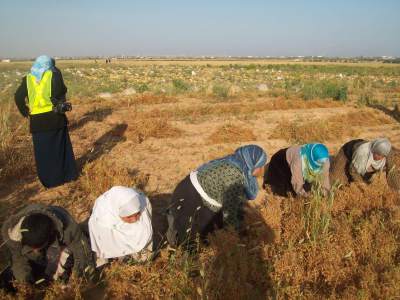
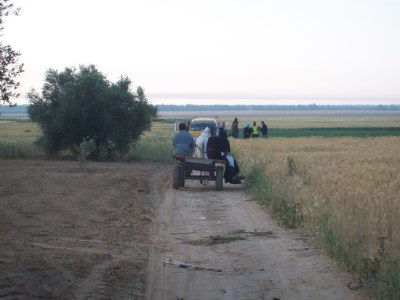

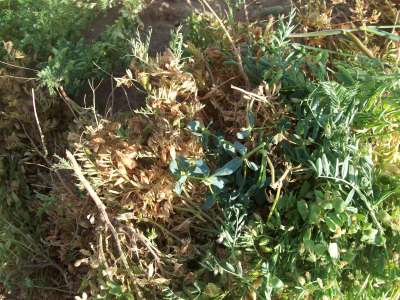
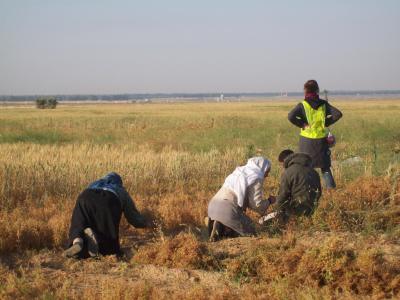



Lentil picking in Khoza'a
Today we accompanied farmers in the Latamat area on the outskirts of Khoza’a. The last time we were out farming in Khoza’a the shooting was the closest I’d experienced, and from the video footage it looked like the Israelis were aiming to shoot my college J in the leg. Since later that same day Wafa was shot in the kneecap, and not too long before that farmer Mohammed was shot in the foot while we were with him, the ISM group had been taking stock of our role. We decided that Gaza ISM had to hold meetings with any farmers that wanted our accompaniment and be absolutely sure they understood that our presence protects them only mildly if in fact it protects them at all.

7am - an early start sometimes means less shooting
My personal feeling was that as long as they are clear on that, then if they still want us we should still go, but then I have to leave Gaza soon. In the Khoza’a meeting (this included showing our video footage of the Faraheen shooting of Mohammed and telling them about Tristan’s shooting and the past killings of ISMers) the farmers replied “Ok, maybe they shoot at us when you are with us, well we’re used to that because they shoot at us when you are not with us. So it’s normal. But if you are with us when it happens - at least you can tell the world about it.”

Today's workers were mostly women
So we met the mostly women farmers at 7am (often women work the most dangerous areas in the hope the soldiers will shoot less) and walked to the fields which were about 4-500 metres from the border. Today’s crop was lentils. I have never seen a lentil plant before, and I certainly hope no-one has to shell the lentils individually cos that would really be some job.

This is what a lentil plant looks like!
The farmers told us they had been shot at the day before in this same field. Several of us had had bad dreams the night before, and I’d written a quick will with various keepsakes for Gaza friends. In the van, E and I exchanged computer passwords and emergency contact numbers. (Actually, I’ve noticed her looking speculatively at me sometimes, since I told her she gets my laptop if something happens to me here.) She also informed me that for her martyr poster if she died, she wanted a picture of her with a donkey. So it was with somewhat of a sense of doom we walked down the track among golden wheatfields. And when explosions started shaking the ground, we wondered if we should even keep going. We rang our friend J in Faraheen, since they seemed to be coming from his direction.

E looks ready to take the soliders on all by herself...
But he told us that actually what we could hear was a fight between Palestinian resistance, and Israeli occupation forces, in Maghazi camp (where Dr Halid - who is a nurse not a doctor - and his family live) which was a lot further north. So the lentil picking got underway and we tried to feel reassured by the fact that the F16s and Apaches flying overhead, and the distant roaring, were not directed at us. But I couldn’t help imagining what it must be like to be a resistance fighter on the ground facing those Apaches and F16s.

An anxious eye on the border
Anyway, it wasn’t long before two jeeps turned up at the border, and Israeli soldiers got out. We waited for the inevitable, and it came - a short burst of shooting only broadly in our general direction. The women working on the ground tensed up and waited. But that turned out to be it. The soldiers got back in the jeeps, and the jeeps drove off again. Some hours later, lots of lentils were picked, the sun was high, everyone was relaxed, and the morning was a success. You can see my colleage G’s Youtube footage of the brief shooting, which he has cheekily finished with a minute or two of me and E entertaining ourselves with some of the dubke dance steps we’ve learnt. You can also find a report of the day and archived articles and videos at the new blog Gaza ISMers have created to support the campaign to protect Gaza farmers, at http://farmingunderfire.blogspot.com/. Please tell your friends.

...and picking as quickly as possible
Later we heard that in Maghazi camp, two fighters were killed, 2 injured, and an Israeli soldier was injured and an Israeli jeep destroyed. I texted Dr Halid and asked how the little girls were. “My children are used to bombing now”, he replied resignedly. I can’t help but feel like the resistance fighters took the fire for us today. If Israel hadn’t been busy shooting at them, from past experience it seems a sure thing they would have stuck round to shoot at us, like they had at the same farmers in the same place the day before. I guess that’s why the resistance is called the resistance.
Later that afternoon, V and I were sitting smoking shisha, looking out at the sea, and gunfire got our attention again. Squinting, we spotted another Israeli gunship, tormenting another Palestinian fishing boat. The gunboat alternated tightly circling the fishing boat with drive-by shooting; we could see the spray as the bullets hit the water. It reminded me of nothing more than a cat playing with a mouse. This was still going on several hours later when we left.
Today, E heard that yesterday a woman she visited in Al Shifa hospital, Ghada, the 21 year old mum of two little girls, finally died in an Egyptian hospital of her horrendous white phosphorous burns. Before she was sent out to Egypt she gave her testimony to my friend M, one of the Al Quds Red Crescent workers, and it is posted here on the B’T Selem website. Please read it. It’s the least we can do.
Oh…and Israel dropped its internal investigation into possible war crimes by the Israeli army in the Dec/Jan attacks.
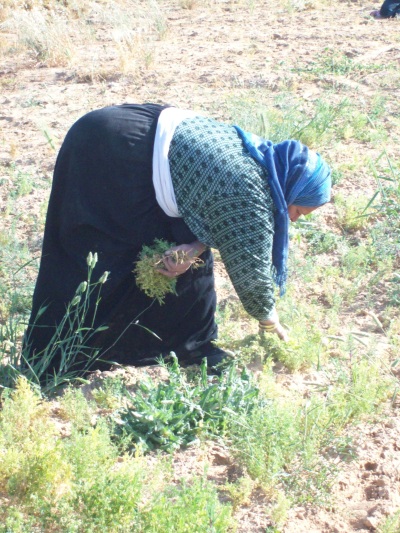
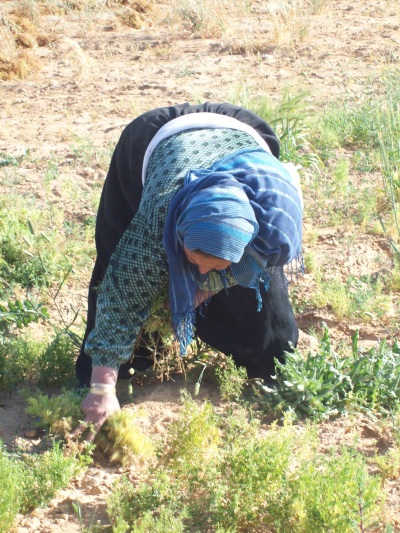
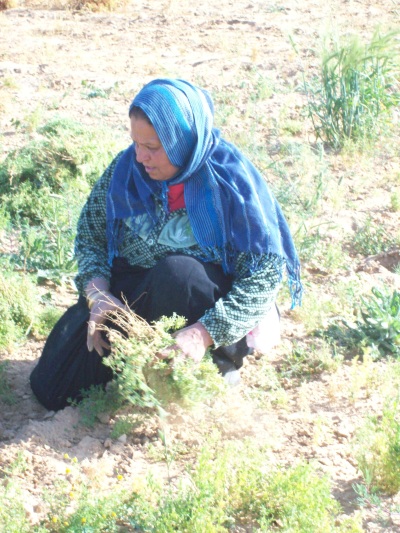
Labels:
ISM,
Israeli attacks during ceasefire
Subscribe to:
Posts (Atom)


















